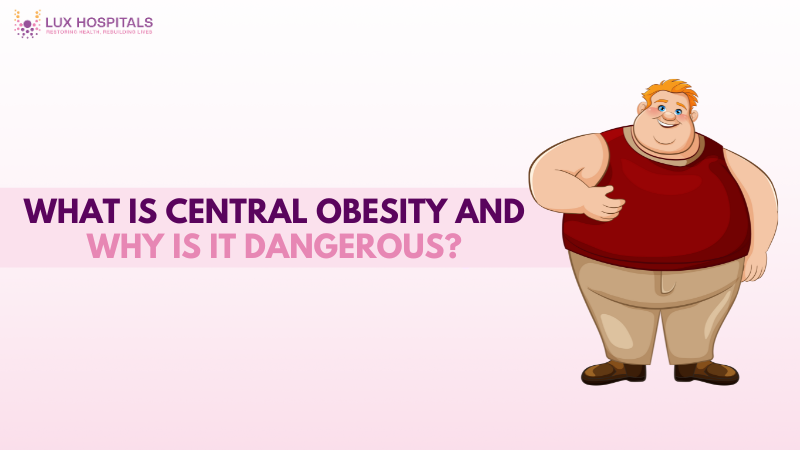What Is Central Obesity, and Why Is It Dangerous?

Central obesity is more than just excess weight—it refers to the accumulation of fat around the abdomen, giving a person an “apple-shaped” body. Unlike fat in other parts of the body, abdominal fat surrounds vital organs such as the liver, pancreas, and intestines. This type of fat is particularly harmful as it increases the risk of several chronic diseases. Understanding central obesity, its causes, and its impact on overall health is essential for prevention and management.
Understanding Central Obesity
Central obesity is defined by an increased waist circumference, often accompanied by a high waist-to-hip ratio. Abdominal fat contains visceral fat that envelops internal organs, in contrast to subcutaneous fat, which is found beneath the skin. Because of its metabolic activity, this fat produces inflammatory chemicals that interfere with hormone balance and aggravate existing medical conditions.
Causes of Central Obesity
Several factors contribute to the development of central obesity:
- Poor diet: Consuming a lot of processed foods, sugar-filled beverages, and saturated fats.
- Physical inactivity: A sedentary lifestyle slows metabolism and promotes fat storage.
- Hormonal changes: Especially in postmenopausal women and people with insulin resistance.
- Genetics: The distribution of fat is influenced by family history.
- Cortisol levels can be changed by stress and sleep deprivation, which may accelerate the formation of fat.
Recognizing these causes can help address central obesity more effectively.
Health Risks Associated with Central Obesity
The dangers of central obesity go beyond appearance. It is linked to a range of health complications:
- Type 2 Diabetes: Visceral fat leads to insulin resistance.
- Heart Disease: Increased abdominal fat can lead to elevated cholesterol and blood pressure levels.
- Stroke: Fat deposits cause artery blockages.
- Certain Cancers: Including breast and colorectal cancer.
- Metabolic Syndrome: A cluster of conditions increasing the risk of heart disease and diabetes.
These risks make central obesity one of the most concerning public health issues today.
Diagnosing Central Obesity
Diagnosis of central obesity is typically based on waist circumference measurements:
- For men: More than 40 inches (102 cm).
- For women: More than 35 inches (88 cm).
To determine visceral fat levels, doctors may also employ imaging methods like CT or MRI scans. Serious health issues can be avoided by the early detection of central obesity.
How to Manage Central Obesity
Managing central obesity requires lifestyle changes:
- A balanced diet focuses on whole grains, lean proteins, fruits, and vegetables.
- Regular exercise: Aim for at least 150 minutes of moderate-intensity activity per week.
- Stress management: Yoga, meditation, and relaxation techniques help regulate cortisol levels.
- Adequate sleep: Poor sleep increases abdominal fat accumulation.
- Medical intervention: In extreme situations, physicians could suggest bariatric surgery or medication as a course of treatment.
A structured approach can effectively reduce central obesity and improve overall health.
Prevention of Central Obesity
Preventing central obesity is easier than managing it. Key steps include:
- Maintaining a healthy weight through portion control.
- Staying active with daily physical activities like walking or cycling.
- Reducing processed food and sugar intake.
- Managing stress levels effectively.
- Having regular health checkups to track waist measurements.
Taking these preventive measures significantly lowers the risk of developing central obesity.
The Link Between Central Obesity and Mental Health
Central obesity affects both physical and mental health. Obesity is often associated with anxiety, depression, and low self-esteem. Additionally, the stress hormone cortisol can worsen mood disorders and add to belly fat, creating a vicious cycle of poor mental and physical health. In order to treat central obesity, mental health must be addressed.
When to Seek Medical Help?
If changing one’s lifestyle doesn’t reduce central adiposity, it’s important to consult a healthcare provider. Physicians are able to assess underlying medical conditions that may be causing weight gain, such as hormonal imbalances or metabolic abnormalities. Long-term issues linked to central obesity can be avoided with early medical intervention.
Conclusion
Central obesity is more than a cosmetic concern—it is a serious health issue that increases the risk of heart disease, diabetes, and other chronic conditions. Understanding its causes, risks, and preventive measures is vital for better health outcomes. By adopting a healthy lifestyle, managing stress, and seeking medical help when necessary, you can effectively combat central obesity and protect your long-term health.




















